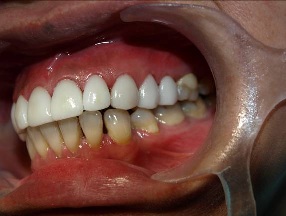Introduction
Dental veneer is a thin layer of restorative material that is bonded onto the front side of a tooth. It is a conservative method to improve the aesthetics of a tooth, or to protect a damaged tooth surface. There are two main types of material used to fabricate a veneer; composite and dental porcelain. Composite veneer is usually directly placed in the mouth, while porcelain veneer is indirectly fabricated by a dental technician in a dental laboratory.
Advantages
The advantage of veneers is that they conserve the tooth structure. Only about 0.5 mm of enamel reduction is needed, and since it is confined to the enamel layer, local anaesthesia is not usually required. The glass-like ceramic that forms porcelain veneers closely resembles natural tooth enamel. They can be bonded effectively to tooth structure and provide patients with strong, beautiful and natural looking smiles.
Disadvantages
- May appear bulky if tooth reduction is not enough.
- Post-operative tooth sensitivity and pulpal death may occur when tooth preparation is done deeply into dentine.
- Presence of overhanging ceramic or resin cement if finishing is not done adequately by the dentist.
- Staining at the gingival margin may happen if the veneer is not well fitting. This may also be caused by water or blood (if gum bleeds) contamination during cementation.
- De-bonding of veneers may happen when veneers are improperly cemented or when veneers are seated on dentine.
- Expensive.
Indications
Veneers are used as a cosmetic treatment for various dental problems such as:
- Chipped or cracked tooth
- Very slightly discoloured or stained teeth
- Gaps or spaces (diastemas) between teeth
- Misshapened or slightly malaligned teeth
- Slightly crowded teeth
- Worn tooth enamel
- Small teeth
Note: Minimally unsightly conditions can be treated with more conservative treatment alternatives like bleaching, esthetic recontouring of teeth or directly placed composite veneers. However, if teeth are significantly broken down or compromised, crowns are a better and stronger alternative to ceramic veneers.
The dental veneer procedure
The procedure can often be completed in three dental visits. At the first visit, the dentist will first plan the treatment by determining the size, shape, and type of veneers that will best complement the smile, face shape, and aesthetic considerations. At the next visit tooth preparation will be done by removing a small amount of enamel to accommodate the veneer. Temporary veneers (when reduction has involved dentine) may be placed to protect the teeth while the permanent veneers are constructed in a dental laboratory. When the permanent veneers are ready, the patient will return for the third visit to have them cemented.
Case 1: Patient with tooth discolouration

Before the procedure

Tooth preparation

Veneers cemented (patient requested the lighter shade)
Case 2: Correcting a peg-shaped lateral incisor

Before the procedure – a peg-shaped lateral incisor
 |
 |
After veneer cementation
Post-Cementation Care.
- Brushing twice daily and flossing at least once daily.
- Avoid biting hard food with veneered teeth.
| Last Reviewed | : | 23 August 2019 |
| Writer | : | Dr. Fauziah bt. Ahmad |
| Reviewer | : | Dr. Roshima bt. Mohd Sharif |







